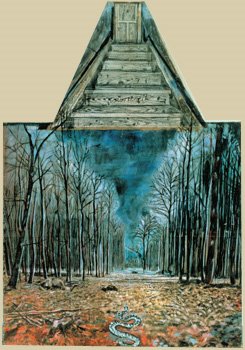Primo Levi's first book was published in the United States under the title
Survival in Auschwitz, and everywhere else under the title
If This Is a Man. (It's absolutely infuriating--this flattening and simplifying of titles for the U.S. market. For example, the film
Regeneration based on Pat Barker's excellent novel of the same name is called here
Behind the Lines. And Levi's second book
The Truce was called here
The Reawakening. Can Americans not comprehend ambiguous or allusive titles? Must we have optimism smiling up from every bookcover?)
If This Is a Man is the perfect title for Levi's account of his imprisonment in Auschwitz. He describes the stripping away of anything that resembles humanity, telling his story and those of others in spare words whose muted intensity makes them all the more compelling. He ends the book with the arrival of the Russians at Auschwitz, told in one sentence between a description of emptying the latrines and carrying out a man who had died in the night. No light at the end of the tunnel, no sense that survival was preordained in any way. It's the immediacy of the book that stands out the most for me: in his preface, Levi describes his motivation in writing as "interior liberation" and notes that the chapters were written in order of urgency, not necessarily of chronology. His direct prose reflects his need to provide a precise, honest accounting of what happened.
The Drowned and the Saved, Levi's last book, is a series of essays examining aspects of the Holocaust forty years later. While he uses himself as an example at times, Levi's concern is with the
univers concentrationnaire and all its inhabitants, living and dead. He begins with the problem of memory, truth, and the many ways in which they are simultaneously unearthed and obscured: through denial and mendacity to be sure, but also through the more natural stylizing of memories on the part of those who have done things which they do not care to remember, and those who cannot bear to remember the events they have lived through.
Levi recreates step by painstaking step the stratification of the Lager and the useless violence that the camp's authorities employed, violence that seemed to serve no point but to inflict pain, "occasionally having a purpose, yet always redundant, always disproportionate to the purpose itself." Yet it seems that inflicting such extreme pain and degradation served a purpose after all: dehumanizing the victims to the point where the murderer's job is easy. And the masters of the univers concentrationnaire managed to dehumanize and murder their victims while keeping their hands clean. The acts of beating and controlling prisoners was delegated to Kapos selected from among their ranks, and gassing was carried out by special details of prisoners, Sonderkommandos, in order to underscore just how subhuman the victims were. Levi states baldly the ultimate effect this useless/useful violence has, an effect other Holocaust writers sometimes seem to ignore: ''It is naive, absurd, and historically false to believe that an infernal system sanctifies its victims: on the contrary, it degrades them, it makes them resemble itself.''
Levi examines the inner workings of degraded victims: Chaim Rumkowski (head of the Judenrat in the Łódź ghetto), the prisoners who served as barracks heads, clerks, Kapos-- all people we might like to condemn for accepting favor or power from their oppressors. He probes their decisions, actions, and excuses calmly and thoroughly-- not justifying or absolving them, but allowing these men and women their unavoidable humanity. We can still judge them-- and in some cases, Levi does--but we cannot refuse to understand them. Witness his words on Rumkowski:
His folly is that of presumptuous and mortal Man as he is described by Isabella in Measure for Measure, the Man who,
Dressed in a little brief authority,
Most ignorant of what he's most assured
His glassy essence, like an angry ape
Plays such fantastic tricks before high heaven
As makes the angels weep.
Like Rumkowski, we too are so dazzled by power and prestige as to forget our essential fragility. Willingly or not we come to terms with power, forgetting that we are all in the ghetto, that the ghetto is walled in, that outside the ghetto reign the lords of death, and that close by the train is waiting.
Levi writes about the past, but he is writing for the present and future. The book ends with a call for the wisdom and action needed to end current violence and the threat of nuclear annihilation, dangers whose genealogy Levi traces back to the violence of Hitler's Germany in a fascinating passage (pp. 200-201.) Interestingly, this makes the book feel more dated, not less, perhaps because the threat of nuclear war and world war has faded. The world seems as much on the brink as ever, but there are many brinks and many prescriptions for action (and many blind eyes), making his language of "we" and "our" and "men of goodwill" seem like what it is, an exhortation from a different era.
In writing The Drowned and the Saved, Levi is trying to erect a dike against the trend of simplification and stereotype and the widening gap between "things as they were 'down there' and things as they are represented by the current imagination, fed by approximate books, films and myths." Levi's tone and his method of inquiry serve his efforts well: scrupulous, precise, analytical, but (and some of his critics miss this) also full of passion, compassion, and condemnation. This clear-eyed vision is what remains with the reader long after Levi’s book is put aside.



